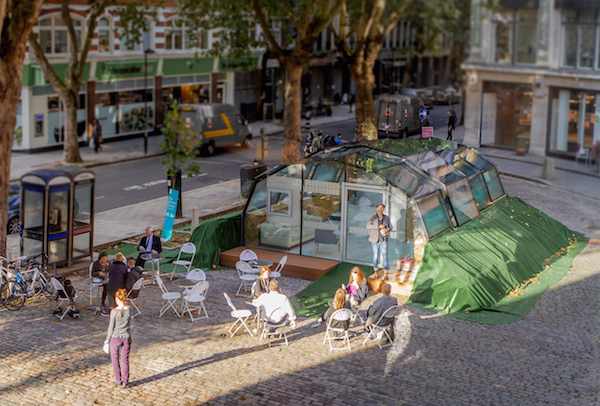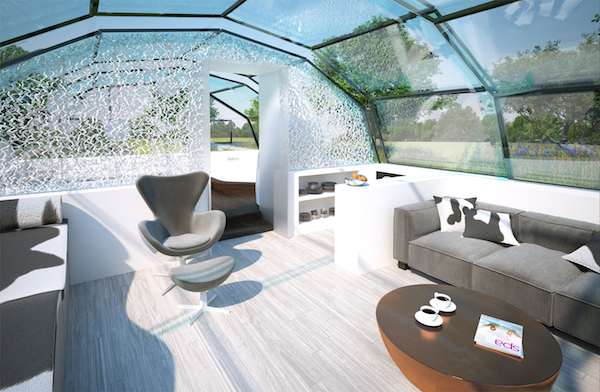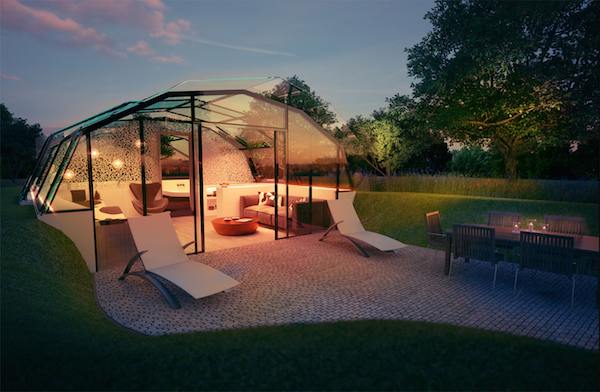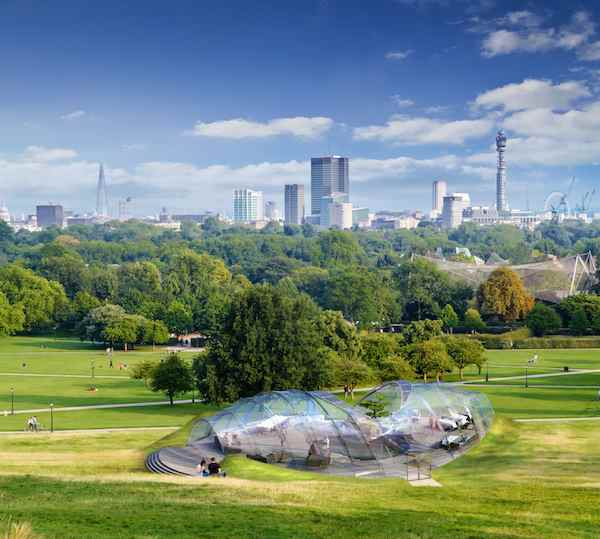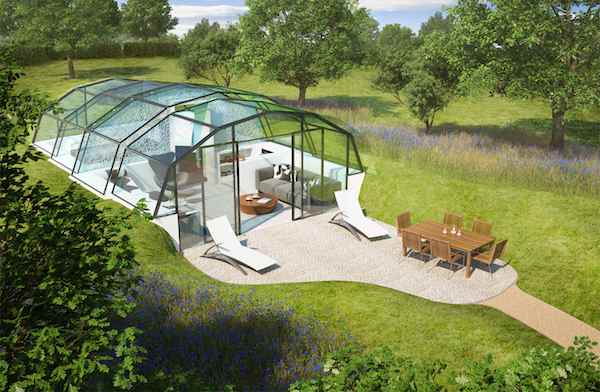
[Image above] The Photon Project’s Photon Space, an all-glass living space that is designed to maximize health through exposure to sunlight. Credit: The Photon Project
Circadian rhythms govern our lives—they determine when we wake, when we sleep, when we eat, how we feel, and other components of our overall well-being. They’re even to blame when you wake up early on your day off.
Circadian (Latin for circa, “around,” and diem, “day”) rhythms follow 24-hour cycles known as Circadian clocks, which are based upon daily light-dark cycles. (Random aside: Did you know our days haven’t always been 24-hours-long?)
These clocks influence daily physical, mental, and behavioral changes—or Circadian rhythms—that respond to light. The rhythms affect sleep-wake cycles, hormone levels, body temperature, energy levels, immunity, libido, and pretty much everything else about your life. Circadian rhythms are also the reason why you experience jet lag.
So when rhythms are messed up, they can contribute to a lot of other problems—including insomnia, diabetes, bipolar disorder, metabolism problems, and much more. Research into Circadian rhythms continues to find additional and unexpected connections to a really wide variety of health issues.
One of the ways to assess the importance of a biological process is to look at people who don’t experience it. Blind people frequently have sleep disorders because they don’t receive 24-hour light-dark stimuli. And animals that have never been exposed to light cycles, like blind cavefish, don’t have Circadian rhythms, an adaptation that actually saves them energy.
Which I hope leads you to one conclusion—light is really important to our bodies and our lives. Unless you’re a cavefish.
Now think about how most of us live—we spend a majority of our time indoors, where our sleep/awake times are governed by artificial lighting. We often don’t wake when the sun does, and, beyond grade school, most of us rarely retire when the sun sets. That’s the luxury of artificial, on-demand lighting. Thanks, Nikola Tesla.
Our Circadian rhythms are also influenced by the constant emission of light from our televisions, computer screens, smartphones, and other devices, which can confuse our biology.
This confusion, many think, is significantly contributing to physical, mental, and behavioral health issues that are becoming increasingly recognized or widespread in the world today.
The profound influence that natural light has on our bodies is precisely the driving inspiration behind the Photon Project, a London-based start-up that is pioneering “disruptive innovation” using glass.
Through several different iterations explained below, the project is experimenting, building, disseminating, and rallying for all-glass enclosures to “promote the benefits daylight has on our health, mood and well-being,” according to the website.
The project has science on its side—it is based upon the work of Oxford University neuroscientist Russell Foster, who discovered that Circadian rhythms are controlled by light collected in special non-visual photoreceptors, which are different from the rods and cones of the eye that give us sight.
The Photon Project’s first clear manifestation was the Photon Pod, a 30 m2 all glass enclosure that was displayed on London’s streets as part of The London Design Festival in 2013. It was an interesting idea, a demonstration, and a way to think differently.
The Photon Pod part of the project had since moved beyond exhibition and into experimentation that is testing the “positive effects of daylight on human biology.” The four-year research project is now gathering data on how light affects subjects living in Photon Pods—for up to three weeks at a time—in Denmark. The project aims to scrutinize 300 participants that will live in nine different pods, providing ample data on how light affects various aspects of human subjects’ lives.
That data, the project hopes, will provide sound evidence for the value and need for its glass structures in modern life.
In the meantime, the Photon Project already commercially sells glass houses, called Photon Spaces, that consumers can assemble themselves. These glass abodes are more spacious with a 45 m2 footprint, which the company expects will be divided into two rooms—a bedroom–bathroom combo and a sitting area–kitchen combo.
The Photon Space is built of double glazed Cantifix glass panels that combine the “most advanced glass technologies available to produce an extremely high performance,” according to the website.
According to an email from Fayza Nawara, business development and marketing manager for The Photon Project, “All the glass is triple layer, but instead of three layers of glass we have a film suspended within a double glazed unit, which gives it very good insulation properties (0.6 W/m2k U-value) and cuts out 63% of solar radiation, 99.5% of UV rays, and 85% of external noise.”
In the name of privacy and shade, the panels can be switched from transparent to translucent with the rearrangement—with the flick of a switch, swipe of a smartphone, or, the company eventually hopes, the gesture of a hand—of “nano-scale particles” that are in a liquid laminated between glass sheets.
According to the project, the special glass used to construct the building means that very little heating or cooling is needed, making the house incredibly flexible in regards to location and mobility—all it needs is electricity and water supplies and a means of waste disposal, according to Nawara.
The company designed the spaces to be mobile, flexible, and integrated into the environment. As they put it on the project’s website:
“The Photon Space is a complete building with an integrated steel sub-frame that allows it to be constructed in virtually all locations within 4 weeks—it touches the earth lightly and can therefore be removed with very little impact on the surroundings, so you can even take it away when you move. The majority of the envelope is glass, structurally bonded to curved glass beams in order to create the unique feel and atmosphere of the internal environment, as well as the vital connection with the outside through the 360 views…The intention is for The Photon Space to ‘nest’ in the environment and become embedded in the surroundings; however this will not always be possible and the building method works just as well on roof-tops, rocky terrains or areas of hard-standing.”
Photon Spaces are shipped to consumers in pieces and can be assembled in less than four weeks, the company says. But before you start dreaming of a glass case of your own, these luxury spaces start at a steep price of £210,000. According to an email from the company, “we have no plans for it to reach a mass market—they are a high performance and high margin luxury building.”
So although a Photon Space in your backyard may be unlikely, the project aims to target the wellness tourism market. The project’s “five to ten year aim is to realize the vision and make The Photon Space fully available to address well-being in public spaces, private gardens, working environments and Eco-retreats,” according to the website.
In another iteration, the project also has a prototype on their website called The Photon House—an all-glass 250 m2 house that the company says was born from a simple question: “What sort of house would we choose to live in if our only consideration was human needs and desires?”
The project is currently crowdfunding via the Kickstarter-esque Crowdcube.
Author
April Gocha
CTT Categories
- Construction
- Environment
- Glass
- Material Innovations
Related Posts
Ohio Creativity Trail: Heisey Glass Museum
January 13, 2026
